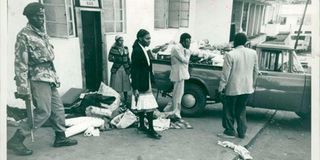
Retired Col Hussein Farah during an interview at the Bluebird Aviation offices situated at Wilson Airport on July 30,2024 on the attempted coup of 1982.
Interviews with retired military officers who had a frontline role in suppressing the August 1, 1982 coup and subsequently in interrogating mutineers reveal that there is one coup plotter who got away.
Although there is no perfect crime, reports have emerged that one air force soldier involved in the mutiny actually fled the country.
This account emerged during interrogations of suspected mutineers at Naivasha Maximum Security Prison, Nation.Africa has established.
After the attempted overthrow of President Moi’s government, the coup leader Senior private Hezekiah Ochuka and his deputy Sgt Pancras Okumu fled to Tanzania but they were later extradited. They were court martialed and hang.
However, retired officers Unshur Mohamed and Hussein Ahmed Farah now say one G.G. Ngatia had planned his gateway in case the coup did not succeed.
“Unlike his colleagues, he is the only one who seems to have had a Plan B. He had a vehicle filled up with fuel, money and a passport ready. When things began to unravel, he drove across the border to Tanzania. From there he flew to Sweden. I believe he is still there. That is the only guy who had a Plan B,” says Unshur who retired as a Major after 12 years.
At the time of the coup, Unshur was a captain with the 50th Air Calvary Battalion (50 ACB). He was among four Kenya army pilots who bombed Eastleigh Airbase to quell the coup. After the coup, Unshur was among six officers who were in a team that interrogated air force soldiers to determine who were implicated in the putsch.
“During interviews at Naivasha prison we were told of one rebel soldier, G.G. Ngatia got away. He still lives in Sweden, I think. You could track him down,” Unshur says.

Police officers guard looted property recovered from a lodging in Kirinyaga Road, Nairobi, following the failed coup attempt on August 1, 1982.
Unshur recalled the only officer tried for involvement in the coup was Lt Lislie Mwambura from Nanyuki airbase. “He was the only officer linked to the coup because the rest were soldiers of junior rank,” the man who retired as a Major after 12 years recalls in an interview with Nation.Africa.
Farah, a captain with the Kenya Air Force, was a deputy parade commander for a guard of honour mounted for President Moi during the Agricultural Society of Kenya (ASK) show in Nyeri on July 31, 1982.
It was the last public event that Moi graced prior to the coup that shook his government and which resulted in a purge of the security machinery that helped him tighten his grip on power.
Unshur narrated that air force soldiers were detained at Kamiti and Naivasha prisons. Unshur says his was tasked to compile files in preparation for court martials at Lang’ata barracks. Those who eventually were accused of complicity in the coup would be brought to Lang’ata barracks from Naivasha Maximum Security Prison.
Farah, who was later cleared after initially being detained alongside the air force colleagues who had mounted the parade at Nyeri ASK show, recalls after vetting one would be issued with one of three cards.
The white card meant you had been cleared, the yellow one indicated you were still a suspect and those issued a red card were considered mutineers who were court martialed. “Many people who were not guilty were punished for nothing,” says Farah who is now chairman of Blue Bird Aviation, a local airline based at Wilson Airport. Farah, 74, retired as a colonel.
After the coup, KAF was disbanded, the service renamed 82 Air Force and later it reverted to KAF. They say the coup failed because the coup plotters had only relied on select juniors.
The two retired officers say that was a dark chapter of Kenya’s history but the Kenya Defence Forces (KDF) has grown to be a professional and reputable institution.
“We should be grateful that the only reason we sleep comfortably at night is because there are men and women who watch over us so that no harm befalls us,” says Unshur.









